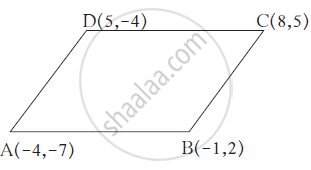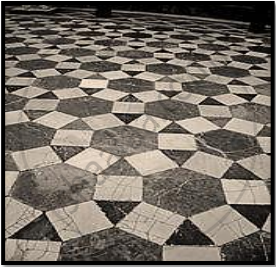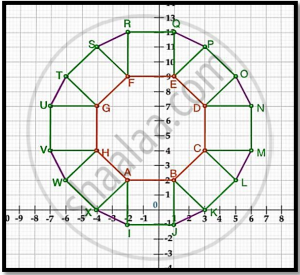Advertisements
Advertisements
प्रश्न
Show that `square` ABCD formed by the vertices A(-4,-7), B(-1,2), C(8,5) and D(5,-4) is a rhombus.
उत्तर

`AD = sqrt((X_2 -X_1)^2 +(Y_2 -Y_1)^2)`
`=sqrt(((5+4)^2 +(-4+7)^2`
`=sqrt(81+9)`
=`sqrt90`
=`3sqrt10 ................. (1)`
BC =`sqrt((8+1)^2 + (5-2)^2)`
`=sqrt(81+9)`
=`sqrt90`
`=3sqrt10 ............(2)`
`AB = sqrt(-1+4)^2 +(2+7)^2`
`=sqrt9+81`
`=sqrt90`
`=3sqrt10` ...............(3)
`CD = sqrt((8-5)^2 +(5+4)^2)`
`=sqrt(9+81)`
`=sqrt90`
`=3sqrt10 ` ...............(4)
From (1), (2), (3) and (4); AB = BC = CD = DA
∴ `square` ABCD is a rhombus.
APPEARS IN
संबंधित प्रश्न
Find the distance between the following pair of points:
(a, 0) and (0, b)
Prove that the points (3, 0), (4, 5), (-1, 4) and (-2, -1), taken in order, form a rhombus.
Also, find its area.
Show that the following points are the vertices of a square:
A (0,-2), B(3,1), C(0,4) and D(-3,1)
In what ratio is the line segment joining A(2, -3) and B(5, 6) divide by the x-axis? Also, find the coordinates of the pint of division.
If the point `P (1/2,y)` lies on the line segment joining the points A(3, -5) and B(-7, 9) then find the ratio in which P divides AB. Also, find the value of y.
The midpoint P of the line segment joining points A(-10, 4) and B(-2, 0) lies on the line segment joining the points C(-9, -4) and D(-4, y). Find the ratio in which P divides CD. Also, find the value of y.
Show that the points (−2, 3), (8, 3) and (6, 7) are the vertices of a right triangle ?
Find the coordinates of circumcentre and radius of circumcircle of ∆ABC if A(7, 1), B(3, 5) and C(2, 0) are given.
Mark the correct alternative in each of the following:
The point of intersect of the coordinate axes is
The abscissa of a point is positive in the
Show that the points (−4, −1), (−2, −4) (4, 0) and (2, 3) are the vertices points of a rectangle.
If the vertices of a triangle are (1, −3), (4, p) and (−9, 7) and its area is 15 sq. units, find the value(s) of p.
If the points (k, 2k), (3k, 3k) and (3, 1) are collinear, then k
f the coordinates of one end of a diameter of a circle are (2, 3) and the coordinates of its centre are (−2, 5), then the coordinates of the other end of the diameter are
The line segment joining the points A(2, 1) and B (5, - 8) is trisected at the points P and Q such that P is nearer to A. If P also lies on the line given by 2x - y + k= 0 find the value of k.
If segment AB is parallel Y-axis and coordinates of A are (1, 3), then the coordinates of B are ______
Signs of the abscissa and ordinate of a point in the second quadrant are respectively.
Point (–10, 0) lies ______.
If the points P(1, 2), Q(0, 0) and R(x, y) are collinear, then find the relation between x and y.
Given points are P(1, 2), Q(0, 0) and R(x, y).
The given points are collinear, so the area of the triangle formed by them is `square`.
∴ `1/2 |x_1(y_2 - y_3) + x_2(y_3 - y_1) + x_3(y_1 - y_2)| = square`
`1/2 |1(square) + 0(square) + x(square)| = square`
`square + square + square` = 0
`square + square` = 0
`square = square`
Hence, the relation between x and y is `square`.
A tiling or tessellation of a flat surface is the covering of a plane using one or more geometric shapes, called tiles, with no overlaps and no gaps. Historically, tessellations were used in ancient Rome and in Islamic art. You may find tessellation patterns on floors, walls, paintings etc. Shown below is a tiled floor in the archaeological Museum of Seville, made using squares, triangles and hexagons.

A craftsman thought of making a floor pattern after being inspired by the above design. To ensure accuracy in his work, he made the pattern on the Cartesian plane. He used regular octagons, squares and triangles for his floor tessellation pattern

Use the above figure to answer the questions that follow:
- What is the length of the line segment joining points B and F?
- The centre ‘Z’ of the figure will be the point of intersection of the diagonals of quadrilateral WXOP. Then what are the coordinates of Z?
- What are the coordinates of the point on y-axis equidistant from A and G?
OR
What is the area of Trapezium AFGH?
